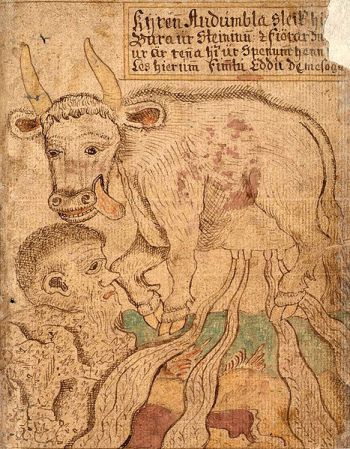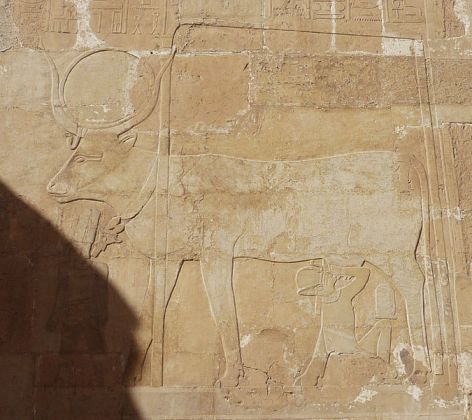Norse mythology is full of captivating stories and characters, but one figure that stands out is Audhumla, the primordial cow. Along with the jötunn Ymir and the first god Büri she is among the first three beings in existence. In Old Norse, her name is Auðumbla, pronounced [ˈɔuðˌumblɑ] and she is also called Auðhumla and Auðumla.
Meaning of Name and Etymology
Audhumla is only mentioned in Snorri’s Prose Edda, but that doesn’t necessarily mean there haven’t been mentions in other texts. The name is a compound name stemming from the Old Norse words auðr, meaning “riches,” and *humala”, meaning “hornless”. Put together the commonly agreed meaning of the name is “hornless cow rich in milk”.
Interestingly, the cow’s name presents some level of semantic ambiguity. A parallel can be found in Scottish English “humble-cow,” meaning “hornless cow,”. Moreover, Northern Europeans have bred hornless cows since prehistoric times. While “hornless cow rich in milk” remains the generally accepted interpretation, the Old Norse word “auðr” can also mean “fate” or “desolate; desert.” This could suggest that Audhumla’s name might have also been understood as the “destroyer of the desert,” possibly this ambiguity may have been intentional.
Audhumla’s Birth and Role in Creation
Our journey begins at the birth of Audhumla. Picture this: the vast void of Ginnungagap where the realms of fire, Muspelheim, and ice, Niflheim, meet. It is from this interaction of fire and ice that Audhumla emerges alongside Ymir, the primordial giant. These two beings, a giant and a cow, set the stage for the creation of the cosmos in Norse mythology.

Audhumla’s story is described in the Prose Edda, a 13th-century text composed by the Icelandic scholar Snorri Sturluson. According to the Edda, Ymir, the primordial frost jötunn, fed on her milk. While she was licking away at salty rime rocks for sustenance. Later, over a three day period her licking reveals Búri, the first god, in the ice. He will become the grandfather of the gods and brothers Odin, Vili, and Vé.
Symbolism of Audhumla
From reading a lot of Norse mythology, it is clear to me that Audhumla’s symbolism goes far beyond her role in the creation myth. As a life-giving figure, she represents fertility, abundance, and nourishment. These qualities are not only vital for the survival of the cosmos but also resonate with human life and society.
A fascinating connection between Audhumla and the concept of wealth and fertility can be found in the rune symbol Fehu. This rune, representing a cow, or cattle, is commonly associated with wealth, fertility, and prosperity. It is no coincidence that Audhumla, the primordial cow, embodies these qualities and plays a crucial role in the birth of the Norse cosmos.
Furthermore, the Fehu rune has well-known associations with Freyr and Freyja, the Vanir gods who are closely connected to agricultural abundance and fertility. As deities of fertility, they symbolize the life-giving forces that Audhumla embodies. Freyr, specifically, is a god of prosperity and peace, while Freyja is a goddess of love, beauty, and fertility. Their close connection to the Fehu rune and, by extension, Audhumla, highlights the importance of the primordial cow in the Norse worldview and emphasizes the significance of fertility and abundance in their culture.
Audhumla’s Connections to Other Mythologies
Audhumla’s prominence in Norse mythology resonates with similar themes found in other mythologies around the world. The primordial cow’s role as a life-giving force and a symbol of fertility, abundance, and nourishment is echoed in various ancient cultures.

In Egyptian mythology, the goddess Hathor is often depicted as a cow-headed figure or a woman wearing a headdress with cow’s horns. As the goddess of love, joy, and motherhood, Hathor embodies the nurturing and life-giving aspects that are also associated with Audhumla. Like the Norse primordial cow, Hathor plays a vital role in creation and sustenance, symbolizing the essential qualities required for life and growth.
Similarly, in Greek mythology, the goddess Hera is described as ‘the cow-eyed,’ alluding to her connection with cows and fertility. As the goddess of marriage, women, and childbirth, Hera is also linked to the concepts of abundance and nourishment. Her epithet, ‘cow-eyed,’ suggests a connection to the life-giving qualities that Audhumla represents in Norse mythology.
Last Thoughts on the Cosmic Cow
In conclusion, Audhumla, the cosmic cow, is a vital character in Norse mythology. Her role in nurturing Ymir, uncovering Buri, and symbolizing fertility and abundance highlights her significance in the Norse creation narrative. Through her story, we can gain a deeper understanding of the values and beliefs of the Norse people, as well as appreciate the interconnectedness of mythologies across the world.
Though she might not be as well-known as some other figures in Norse mythology, Audhumla’s story is a captivating and essential part of the Norse creation myth. So, the next time you encounter a cow or hear the word “udder,” let your mind wander to the tale of Audhumla, the cosmic cow, and her vital role in shaping the Norse cosmos.
FAQs about Audhumla
Audhumla is the primordial cow in Norse mythology, born from the melting ice of Ginnungagap. She played a crucial role in the creation story by nourishing Ymir and uncovering Buri, the first god.
Audhumla emerged from the ice of Ginnungagap when the heat from Muspelheim, the realm of fire, caused it to melt. This event marks the beginning of life in Norse mythology.
Audhumla’s name in Old Norse is believed to mean “wealthy cow” or “udder-cow.” This reflects her nurturing and life-giving role in the Norse creation story.
Audhumla uncovered Buri by licking the salty ice of Ginnungagap. As she licked the ice for sustenance, she gradually revealed Buri, the progenitor of the gods.
Audhumla symbolizes fertility, abundance, and life in Norse mythology. Her nurturing role in the creation story highlights the importance of these qualities in the Norse cosmos.
Yes, there are connections between Audhumla and other mythologies, such as Egyptian, Hindu, and Greek. Cows and bulls often symbolize fertility, abundance, and life in these cultures, similar to Audhumla’s role in Norse mythology.
Featured Image Credit: Nicolai Abildgaard, Public domain, via Wikimedia Commons

Great little article. I liked the way you showed something found in both Greek and Norse mythology.
Thanks a lot Marco, appreciate you taking the time to share your thoughts!
Marius